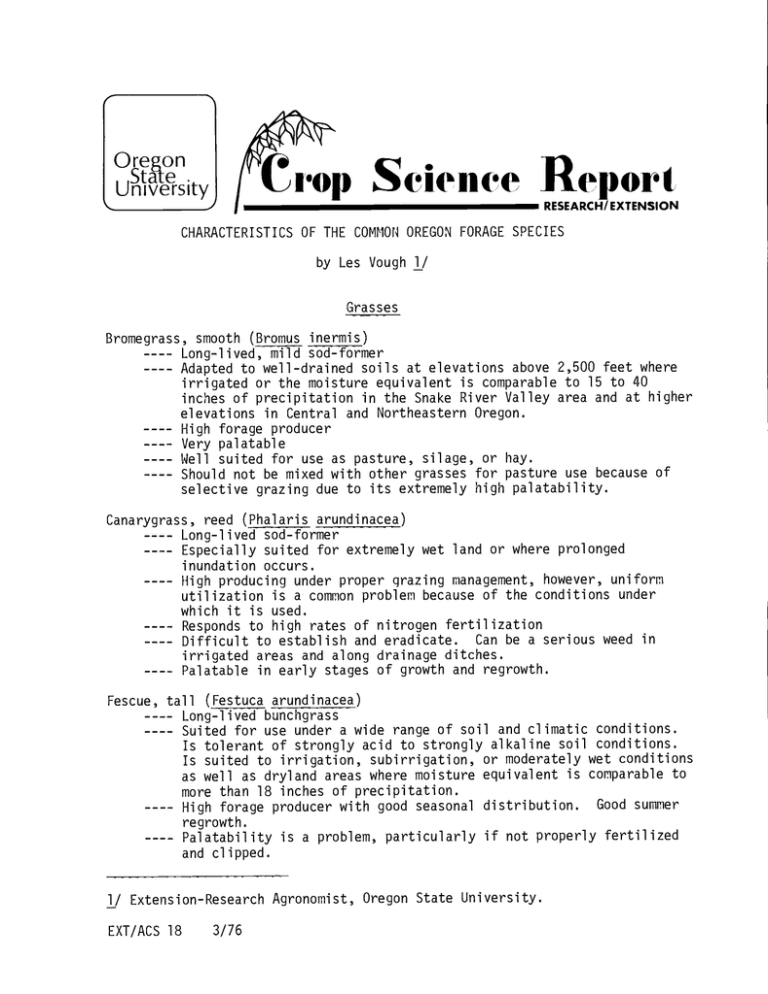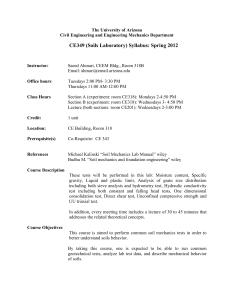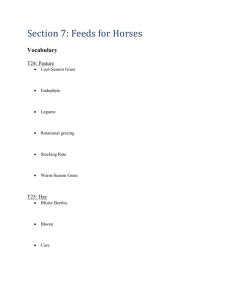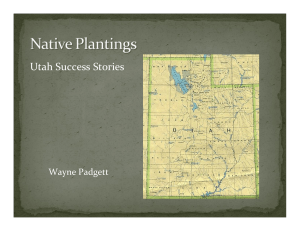Science Report rop Oregon University
advertisement

Oregon State University rop Science Report . RESEARCH/EXTENSION CHARACTERISTICS OF THE COMMON OREGON FORAGE SPECIES by Les Vough 1/ Grasses Bromegrass, smooth (Bromus inermis) --- Long-lived, mild sod-former --- Adapted to well-drained soils at elevations above 2,500 feet where irrigated or the moisture equivalent is comparable to 15 to 40 inches of precipitation in the Snake River Valley area and at higher elevations in Central and Northeastern Oregon. High forage producer ---- Very palatable Well suited for use as pasture, silage, or hay. --- Should not be mixed with other grasses for pasture use because of selective grazing due to its extremely high palatability. Canarygrass, reed (Phalaris arundinacea) Long-lived sod-former ---- Especially suited for extremely wet land or where prolonged inundation occurs. High producing under proper grazing management, however, uniform utilization is a common problem because of the conditions under which it is used. --- Responds to high rates of nitrogen fertilization Can be a serious weed in --- Difficult to establish and eradicate. irrigated areas and along drainage ditches. --- Palatable in early stages of growth and regrowth. Fescue, tall (Festuca arundinacea) --- Long-lived bunchgrass --- Suited for use under a wide range of soil and climatic conditions. Is tolerant of strongly acid to strongly alkaline soil conditions. Is suited to irrigation, subirrigation, or moderately wet conditions as well as dryland areas where moisture equivalent is comparable to more than 18 inches of precipitation. Good summer - --- High forage producer with good seasonal distribution. regrowth. ---- Palatability is a problem, particularly if not properly fertilized and clipped. 1/ Extension-Research Agronomist, Oregon State University. EXT/ACS 18 3/76 2 --- Generally not compatible with other grasses due to palatability problem. High level pasture management required if it is mixed with other grasses. Fairly compatible with white clover - --- Must be cut early for hay or silage - --- Has fast regrowth - --- Has some winter activity, i.e., grows at relatively low temperatures --- Produces a heavy sod of root material New seedings start slowly; should not be planted in mixtures with more than 20% ryegrass. ---- Shade tolerant Foxtail, meadow (Alopecurus pratensis) --- Long-lived, weak sod-former Expecially adapted to wet soils and to land subject to flooding in winter or early spring. Is tolerant of frost and prolonged snow cover (adapted to high altitudes), making it well suited for moist mountain meadow plantings. Tolerant of mild alkaline and salt conditions. - --- Responds to high fertility Has a long season of use and no dormant period except in freezing weather. - --- Very palatible Difficult to seed - requires carrier for the seed if seeded through standard drill or requires special seeding equipment. Orchardgrass (Dactylis glomerata) --- Long-lived, high producing bunchgrass Can be grown - --- Widely adapted to well-drained soils throughout Oregon. under irrigation or on dryland where the moisture equivalent is comparable to 18 inches or more precipitation. - --- Suited for pasture, hay, or silage ---- Very palatable ---- Must be cut early for hay or silage, otherwise can be very stemmy. Fast regrowth New seedings develop rather quickly --- Shade tolerant - --- Subject to leaf spots and rusts Good summer regrowth if adequate moisture is available or if irrigated. Late maturing varieties are very compatible for use with legumes for hay and silage. Ryegrass, annual (Lolium multiflorum) Vigorous growing, winter-active annual Adapted west of the Cascades to a wide variety of soil conditions, Can be grown under irrigation or on including poorly drained soils. dryland where the moisture equivalent is comparable to 12 inches or more precipitation. ---- Makes a good winter cover crop or temporary seeding on disturbed areas. Extablishes rapidly, is very competitive and may retard establishment of perennial grasses and legumes if it is seeded too heavily as a component of a mixture. Tetraploid varieties have similar winter activity and production. 3 Ryegrass, perennial (Lolium perenne) ---- Intermediate-lived bunchgrass well suited for use in short rotations with clover. --- Adapted west of the Cascades to a wide variety of soil conditions including poorly drained soils. Can be grown under irrigation or on dryland where the moisture equivalent is comparable to 15 inches or more precipitation. - --- May retard establishment of other perennial grasses and legumes if it is seeded too heavily as a component of a mixture. - --- Has good recovery after grazing in the spring but tends to go dormant in summer. - --- Very palatable --- Less winter-hardy than orchardgrass, timothy, and tall fescue Responds to high fertility - --- Medium high in forage production Has some winter activity,1.e. grows at relatively cool temperatures. Timothy (Phleum pratense) - --- Intermediate-lived bunchgrass. --- Adapted to high elevations and where moisture equivalent is comparable to 18 inches or more precipitation. --- Comparatively poor regrowth under warm dry conditions. - --- Is a productive hay crop --- Has special value in revegetating forested lands in Eastern Oregon, Southern Oregon, and the eastern portion of the Willamette Valley. --- Its late maturity may be an advantage under certain conditions, such as poorly drained soils. Wheatgrass, beardless (Agropyron inerme) Long-lived drought-tolerant bunchgrass. --- Adapted where moisture equivalent is comparable to 9 to 18 inches of precipitation. ---- Provides later green forage than crested wheatgrass. --- Generally has low seedling vigor which delays establishment about one year. - --- Not as hardy as crested wheatgrass but more palatable. --- Use in bluebunch wheatgrass habitats. Wheatgrass, crested (Agropyron desertorum) --- Extremely long-lived, drought-tolerant bunchgrass. --- Provides excellent early spring grazing, becoming more or less dormant during hot dry periods. - --- Is one of the best adapted grasses for use where the moisture equivalent Most hardy dryland is comparable to 9 to 18 inches of precipitation. grass. --- Because of its good early spring production, good palatability, and nutritive qualities, it is of special value for early pasture before native grasses are ready for grazing. 4 Wheatgrass, intermediate (Aqropyron intermedium) --- Long-lived mild sod-former, however not as long-lived as crested wheatgrass and good pasture stands are difficult to maintain for more than six years. --- Late maturing, making a long pasture season. Hay yields are --- Suitable for hay or pasture alone or with alfalfa. higher than for most other adapted grasses. --- Can be grown under irrigation or on dryland where the moisture equivalent is comparable to 15 inches or more precipitation. --- Requires good drainage and moderate to high fertility. - --- Virtues are its large seed, ease of establishment, rapid growth, and sod-forming characteristics. --- Not as winter hardy as crested wheatgrass, and if incorrectly managed, stands may deteriorate rapidly. Wheatgrass, pubescent (Agropyron trichophorum) --- Long-lived sod-former. --- Adapted to low-fertility sites and fine-textured soils where moisture equivalent is comparable to 12 to 60 inches of precipitation. ---- Closely related to intermediate wheatgrass, the two being quite similar in growth habit, period of growth, and taxonomic characteristics. Will tolerate drier and more alkaline soil conditions than intermediate wheatgrass. ---- Better adapted for pasture than hay. Wheatgrass, Siberian (Agropyron sibericum) ---- Long-lived, drought-tolerant bunchgrass. - --- Closely related to Norclan crested wheatgrass and is similar in appearance, but stems are finer. --- Slightly more drought-tolerant than crested, especially on coarsetextured or sandy soils. Seedlings less vigorous than those of Nordan crested wheatgrass. Wheatgrass, tall (Agropyron elongatum) --- Tall, coarse, long-lived bunchgrass. --- Can be grown under irrigation or on dryland where the moisture equivalent is comparable to 12 inches or more precipitation. Has greater Has special adaptation to moist, heavy alkali soils. tolerance to alkali than any other forage grass cultivated in Oregon. Late maturing, providing a long grazing period when used for pasture but is not as palatable as most other wheatgrass. --- Does not endure continuous close grazing. --- Good seedling vigor. Legumes Alfalfa (Medicago sativa) ---Long-lived, herbaceous perennial with numerous varieties which have specific characteristics for given purposes. Often called ----Is one of the most important forage plants in the U.S. the "Queen of the Forages." ---Suited for use as hay, pasture, or silage under irrigation or on dryland where the moisture equivalent is comparable to 12 inches Grows extremely well in dry climates on or more precipitation. irrigated fertile soils. Good drainage ---Best adapted to deep loam soils with porous subsoils. is essential. 5 ---Generally requires large amounts of lime and does not do well on acid soils. Is relatively tolerant to alkaline soils but does not do well on highly alkaline soils. ---Is highly drought resistant, but goes into dormancy during drought periods and resumes growth only when moisture conditions become favorable. ---Has a distinct tap root system, which under favorable conditions, may penetrate the soil 25 to 30 feet or more. ----Has the highest feeding value of all commonly grown hay crops. Produces more protein per acre than any other crop for livestock, including soybeans. ---In some situations the most efficient use of alfalfa is in combination with corn silage, where the protein of alfalfa compliments the energy from corn. tolerate pasturing when rotationally grazed. Stands weaken rapidly if grazed continuously. In general, mixture with a grass such as orchardgrass is recommended when it is used primarily as pasture. Clover, red (Trifolium pratense) ---Short-lived perennial best suited for hay and silage in three- and four-year crop rotations. ----Adapted under irrigation or on dryland where the moisture equivalent is comparable to 26 inches or more precipitation. Best adapted where summer temperatures are available throughout the growing season. ----Has a taproot system with many secondary branches. A large part of the root system is concentrated in the top 12 inches of soil. ---Fertile, well-drained soils of high moisture-holding capacity are best for red clover. Loams, silt loams, and even fairly heavytextured soils are preferred to light sandy or gravelly soils. -Will grow on moderately acid soils, but maximum yields are obtained only when calcium is adequate and the pH is 6 or higher. ---Can be used in pasture mixtures and for renovating old pastures. Is the easiest legume to establish in closely grazed or renovated sods. Rotational rather than continuous grazing will result in longer life of the stand. Clover, subterranean (Trifolium subterraneum) ---Winter-annual legume ideally suited for foothill and non-irrigated pastures in Western Oregon where the moisture equivalent is comparable to 18 inches or more precipitation. ---Is well adapted to relatively warm moist winters and dry summers, but requires well-drained soils. ---If properly managed, will volunteer freely for many years from seed formed each year. ----Seed is enclosed in a bur. Stiff, forked bristles of the seed bur serve as a mechanism that buries a portion of the burs in the soil, giving rise to the common name, subterrnaean clover. This characteristic, hard seed, and the high temperature dormancy of the seed make the species well-adapted to reseeding itself. ---Especially tolerant to acid soils--pH 5.5 or above. -Will persist under extremely heavy grazing. Ideally suited to combination with perennial ryegrass. 6 ----AVOID use in rotation with row crops. Clover, white (Trifolium repens) - ---Long-lived perennial suited primarily for pasture, but can be used for hay and silage. ---Is most important pasture legume in many parts of the temperate zones. ---Can be grown under irrigation or on dryland where the moisture equivalent is comparable to 18 inches or more precipitation. ---Best adapted to well-drained silt loam and clay soils of pH 6-7, but is tolerant of poor drainage. ---Requires medium to high fertilety and adequate moisture for optimum production. ---Is not tolerant of highly acid, highly alkaline, or saline soils. ----Has prostrate growth habit. - ---Contains higher crude protein and, generally, a higher percentage of each of 16 amino acids than alfalfa, red clover, or birdsfoot trefoil. Consistently higher contents of sodium phosphorus, chlorine and molybdenum than other legumes and grasses. ----May present a bloat hazard when it represents a high precentage of the pasture. The danger can be minimized by proper management and methods of control. Giant type ---Giant in terms of height, leaf size, and other characteristics. ---Very well suited to interior areas of Western Oregon away from the coast, especially for hay and silage. -- -Will winter-kill under dry winter conditions. ---Susceptible to slug damage. ---Requires high soil phosphate levels and good management for maximum. ---Ladino is a giant type of white clover. Intermediate type ---Intermediate in terms of height and leaf size. ---Very well adapted to locations along the coast and interior Western Oregon where slugs are a problem. ---Responds to good management and fertilization. ----New Zealand, White Dutch, and common white clovers are intermediate types. ----Seed should be obtained from a climate similar to that of the area to be seeded. Trefoil, birdsfoot (Lotus corniculatus) ---Long-lived, deeprooted perennial suited for use as hay, pasture, and silage. ---Can be grown under irrigation or on dryland where the moisture equivalent is comparable to 18 inches or more precipitation. ----Does not create bloat problems. ---Is very winter-hardy. ---Grown on many different types of soils, from clays to sandy loams. Will grow on poorly drained, droughty, infertile, and/or mildly alkaline sods. Although tolerant of rather adverse soil conditions, it is most productive on fertile, moderately well-drained to welldrained soils having a pH of 6.2-6.5 or higher, only slightly lower than for alfalfa. 7 ----Has a taproot system with numerous lateral branches in the upper 12 to 24 inches of soil. Taproot does not penetrate as deeply as alfalfa and the distribution of branch roots in the upper soil is more extensive. ---Although more drought-resistant than ladino clover, it is more susceptible to drought than alfalfa and growth is severely checked during long periods of inadequate soil moisture. ----Chemical composition and nutritive value equal that of alfalfa and other legumes. ---Two distinct types are grown--New York or Empire-type and the European-type. Compared to the European cultivars such as "Cascade," "Granger," "Mansfield," and "Viking," Empire is finer stemmed, more prostrate in growth habit, 10 to 15 days later in flowering, more winter-hardy, slower seedling growth, and slower recovery growth rate after harvest. ---Empire or Empire-type cultivars persist better in permanent pastures than the erect European-type cultivars. European cultivars can be used for pasture, but must be rotationally grazed and managed like alfalfa and red clover. ----Seedling growth rate is slower than alfalfa or red clover. Empire has less seedling vigor than European cultivars. ----Good seeding practices must be used to obtain vigorous stands. Preparation of a smooth firm seedbed and proper placement of the seed into the soil is very importand since seedline emergence is related to depth of planting. On most soils birdsfoot trefoil should be planted no more than 1/2-inch deep. Trefoil, big (Lotus pedunculatus) ---Long-lived, rhizomatous perennial suited for use as pasture and hay in Western Oregon under long duration wetland conditions, and where annual precipitation exceeds 60 inches. ---Withstands considerable winter inundation. ----Is not winter-hardy east of Cascade Range.





